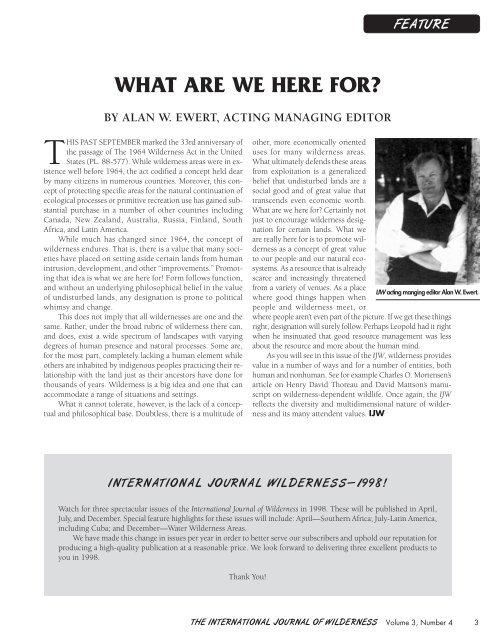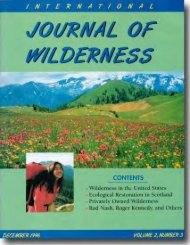Download full PDF - International Journal of Wilderness
Download full PDF - International Journal of Wilderness
Download full PDF - International Journal of Wilderness
Create successful ePaper yourself
Turn your PDF publications into a flip-book with our unique Google optimized e-Paper software.
WHAT ARE WE HERE FOR?<br />
BY ALAN W. EWERT, ACTING MANAGING EDITOR<br />
THIS PAST SEPTEMBER marked the 33rd anniversary <strong>of</strong><br />
the passage <strong>of</strong> The 1964 <strong>Wilderness</strong> Act in the United<br />
States (PL. 88-577). While wilderness areas were in existence<br />
well before 1964, the act codified a concept held dear<br />
by many citizens in numerous countries. Moreover, this concept<br />
<strong>of</strong> protecting specific areas for the natural continuation <strong>of</strong><br />
ecological processes or primitive recreation use has gained substantial<br />
purchase in a number <strong>of</strong> other countries including<br />
Canada, New Zealand, Australia, Russia, Finland, South<br />
Africa, and Latin America.<br />
While much has changed since 1964, the concept <strong>of</strong><br />
wilderness endures. That is, there is a value that many societies<br />
have placed on setting aside certain lands from human<br />
intrusion, development, and other “improvements.” Promoting<br />
that idea is what we are here for! Form follows function,<br />
and without an underlying philosophical belief in the value<br />
<strong>of</strong> undisturbed lands, any designation is prone to political<br />
whimsy and change.<br />
This does not imply that all wildernesses are one and the<br />
same. Rather, under the broad rubric <strong>of</strong> wilderness there can,<br />
and does, exist a wide spectrum <strong>of</strong> landscapes with varying<br />
degrees <strong>of</strong> human presence and natural processes. Some are,<br />
for the most part, completely lacking a human element while<br />
others are inhabited by indigenous peoples practicing their relationship<br />
with the land just as their ancestors have done for<br />
thousands <strong>of</strong> years. <strong>Wilderness</strong> is a big idea and one that can<br />
accommodate a range <strong>of</strong> situations and settings.<br />
What it cannot tolerate, however, is the lack <strong>of</strong> a conceptual<br />
and philosophical base. Doubtless, there is a multitude <strong>of</strong><br />
FEATURE<br />
other, more economically oriented<br />
uses for many wilderness areas.<br />
What ultimately defends these areas<br />
from exploitation is a generalized<br />
belief that undisturbed lands are a<br />
social good and <strong>of</strong> great value that<br />
transcends even economic worth.<br />
What are we here for? Certainly not<br />
just to encourage wilderness designation<br />
for certain lands. What we<br />
are really here for is to promote wilderness<br />
as a concept <strong>of</strong> great value<br />
to our people and our natural ecosystems.<br />
As a resource that is already<br />
scarce and increasingly threatened<br />
from a variety <strong>of</strong> venues. As a place<br />
IJW acting manging editor Alan W. Ewert.<br />
where good things happen when<br />
people and wilderness meet, or<br />
where people aren’t even part <strong>of</strong> the picture. If we get these things<br />
right, designation will surely follow. Perhaps Leopold had it right<br />
when he insinuated that good resource management was less<br />
about the resource and more about the human mind.<br />
As you will see in this issue <strong>of</strong> the IJW, wilderness provides<br />
value in a number <strong>of</strong> ways and for a number <strong>of</strong> entities, both<br />
human and nonhuman. See for example Charles O. Mortensen’s<br />
article on Henry David Thoreau and David Mattson’s manuscript<br />
on wilderness-dependent wildlife. Once again, the IJW<br />
reflects the diversity and multidimensional nature <strong>of</strong> wilderness<br />
and its many attendent values. IJW<br />
INTERNATIONAL JOURNAL WILDERNESS—1998!<br />
Watch for three spectacular issues <strong>of</strong> the <strong>International</strong> <strong>Journal</strong> <strong>of</strong> <strong>Wilderness</strong> in 1998. These will be published in April,<br />
July, and December. Special feature highlights for these issues will include: April—Southern Africa; July-Latin America,<br />
including Cuba; and December—Water <strong>Wilderness</strong> Areas.<br />
We have made this change in issues per year in order to better serve our subscribers and uphold our reputation for<br />
producing a high-quality publication at a reasonable price. We look forward to delivering three excellent products to<br />
you in 1998.<br />
Thank You!<br />
THE INTERNATIONAL JOURNAL OF WILDERNESS Volume 3, Number 4 3










